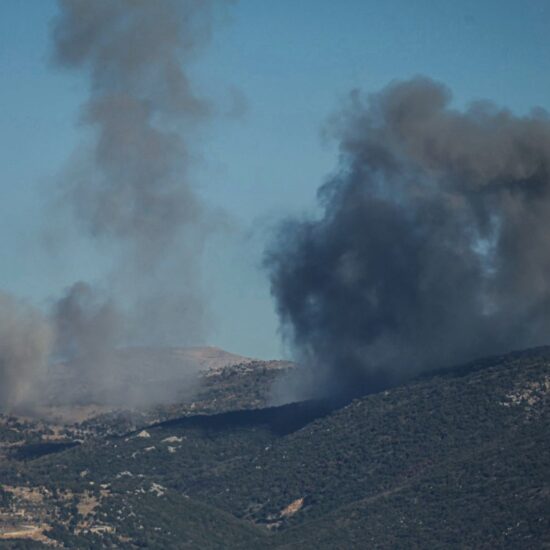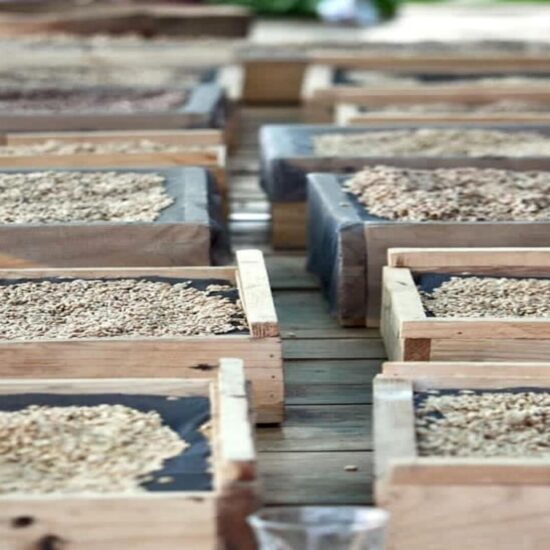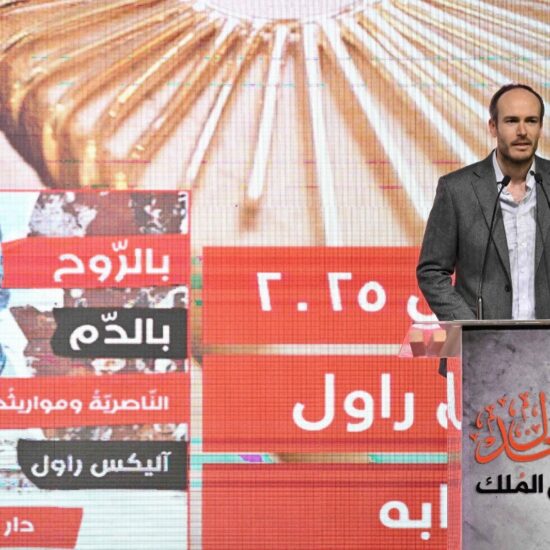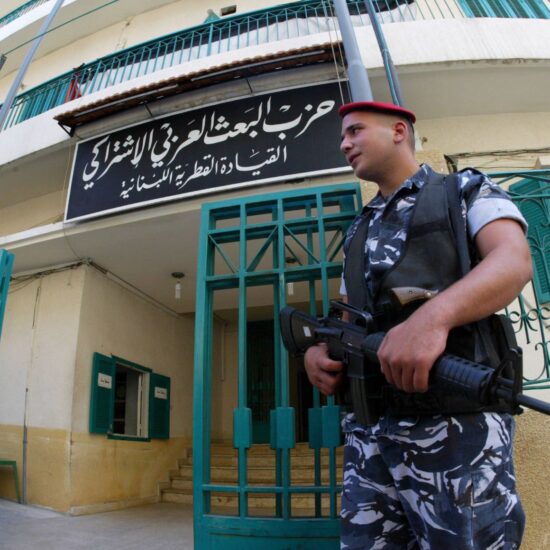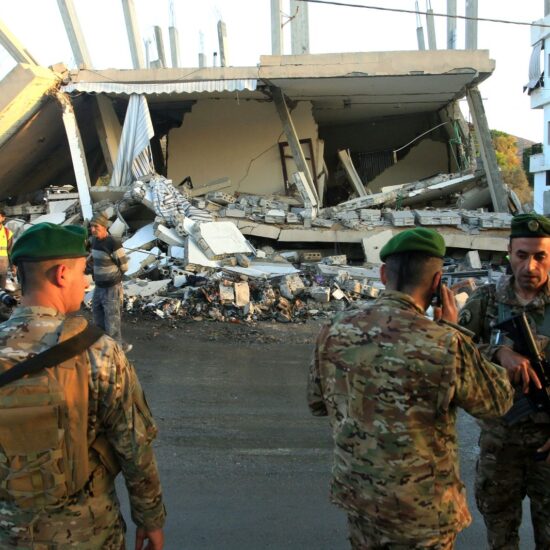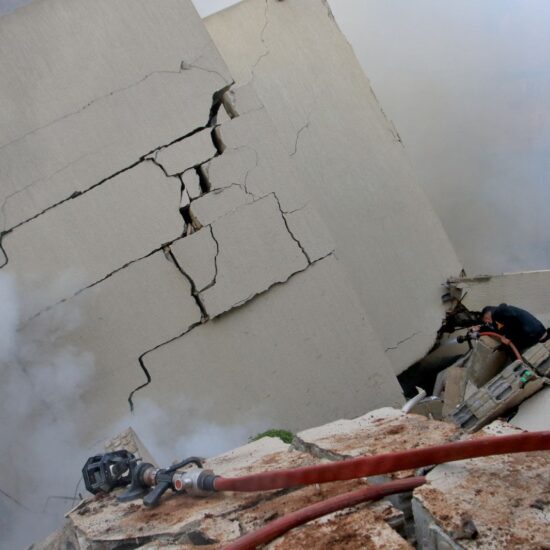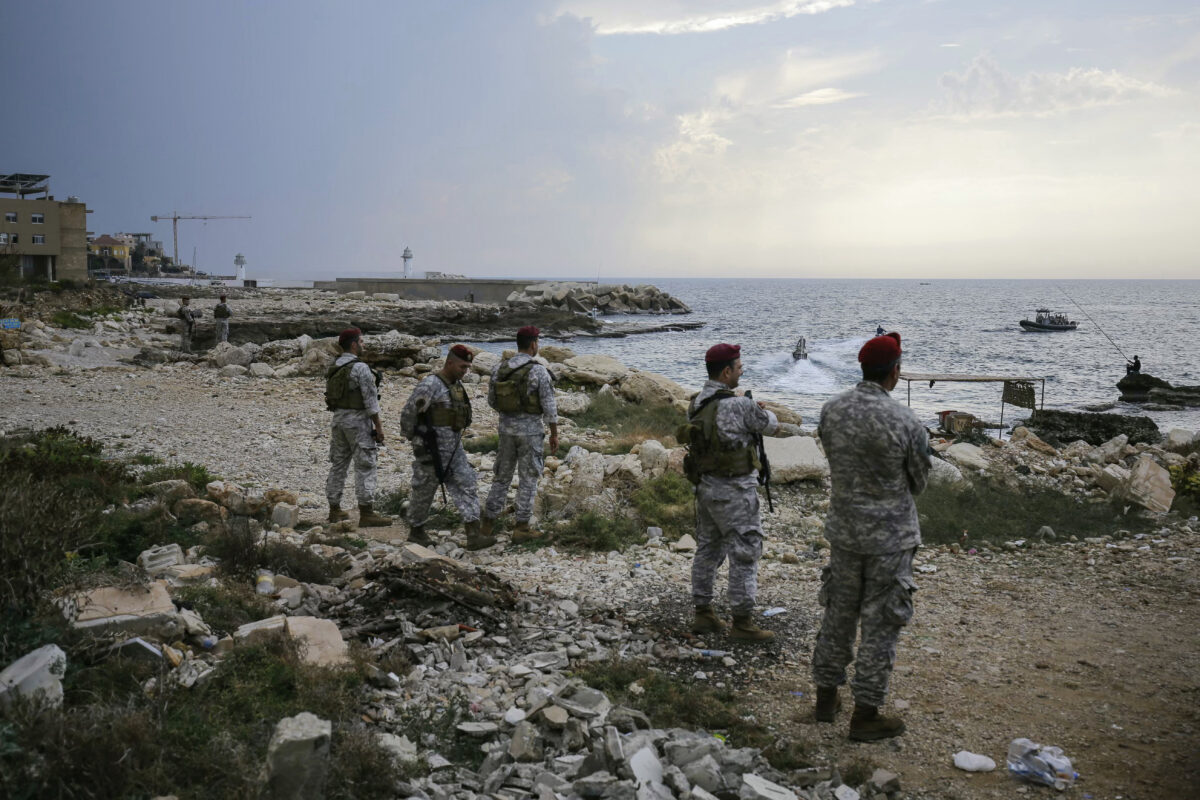
Bodies of trapped civilians recovered in Khiam following Israeli troop withdrawal, Israeli army claims abduction of Hezbollah member in Batroun, US embassy blocks Iraq-Lebanon humanitarian air bridge, As rain starts falling over the country, Lebanese army forcibly evacuates displaced people in Beirut with no where else to go, Water crisis in south-east Lebanon villages after Israeli strike disrupts water infrastructure, Unprecedented Israeli strikes on Jabal Akroum in Akkar region, Baalbek-Hermel and western Beqaa areas under ongoing Israeli attack, UN expert warns Lebanon cultural heritage and sites of worship in peril, Cease-fire with Hezbollah: no deal, says Netanyahu, Israel orders Palestinian refugee camp of Rashidieh in Tyre to evacuate, Israeli strikes in southern Lebanon kill six paramedics, Israeli airstrike on Haret Saida leaves nine dead and 25 injured, Hezbollah names Naim Qassem as new Secretary General, The Israeli army claimed to have eliminated the commander of Hezbollah’s missile and rocket unit Jaafar Khader Faour, Schools to reopen in Lebanon amidst war, Israel bans UNRWA as north Gaza assault grinds on, Hamas, Fatah discuss post-war Gaza governance in Cairo, South Africa to submit dossier of evidence of Gaza genocide to ICJ, Three killed as Israel strikes allegged Hezbollah depots in Syria’s Qusayr, after bombing again the Joussieh border crossing with Lebanon, The Islamic Resistance in Iraq launched four drone attacks against targets in Eilat, Houthis get unprecedented foreign military support, UN reports, Civilian atrocities by the RSF reported in Sudan’s Gezira
Two figures, in the agitated hours that have concluded the past week, with constantly updated numbers that do not stand the passing of the hours: from evacuation orders, to the ever-increasing number of wounded and dead, to that of villages razed to the ground, in the south, and of archaeological sites in peril, in the Beqaa valley. To the one and a half million displaced persons: a quarter of the entire country’s population. Two figures that make us reflect on the incompleteness, the meaninglessness of these numbers: albeit necessary, despite frightening.
One: that the 21 people who had been reported missing since the start of last week in Khiam, in the Marjayoun district of southern Lebanon, have been confirmed dead, according to rescuers from the International and Lebanese Red Cross.
Two: that despite the official death toll in the Gaza Strip since the beginning of the war over a year ago being 43,ooo, a group of health workers who have volunteered in the enclave have estimated that Israel has likely already killed over 119,000 Palestinians, approximately 5.4 percent of the Strip’s population.
Among the many conclusions that can be drawn – the ferocity, the brutality, the personal tragedy of the loss, multiplied by millions – there is the senselessness of counting the dead. Of clinging to sterile figures, insisting on defining their exactness – 2986, in Lebanon alone, and 13,402 wounded – as if to justify, with scientific precision, the extent of the damage this war means. Were it not that what we do not know, in reality, reveals a worse catastrophe: and that the numbers hidden behind the supposed accuracy of the official counts conceal incalculable destruction, an indefinable form of death – that of the aborted hope of finding a living body under the rubble. That one’s home has been spared, that it is still standing: while instead, has been raped – that one as well – by the arrogance of a group of Israeli soldiers, playing a piano in the midst of their own hands’ destruction, wearing displaced women’s clothes, after having stripped them of everything. In Khiam, the furthest into Lebanese territory that the Israeli ground offensive has reached – and where any prior attempt to rescue the missing ones had been impossible until November 3, as the IDF refused the Red Cross to grant access – Hezbollah’s much-acclaimed withdrawal of Israeli troops, retreated under the cover of dozens of white phosphorus shells, artillery, and airstrikes, left behind 21 bodies, five of whom pulled out from under the rubble on Sunday, and the other 16 to be retrieved today, as we speak, and we keep on counting.
Convincing ourselves that the illusion of numbers could somehow scan the passing of a time that has lost its meaning, for the period of days existing between the disappearance and the confirmation of one’s death, has now become the same. And there is no more hope in the wait between not knowing and organising a funeral. It is a straight, objective line, impossible to bend: its course unstoppable. And the gap between the 43,000 confirmed dead in Gaza and the estimated 119,000 – a chasm.
Deconstructing other numbers
Not differently, an account of forced evictions based on the numbers of displaced persons in Lebanon – 1. 4 million – that of official shelters – 1,097, 922 of whom have already reached their maximum capacity – that excludes the rejected ones, not only fails to reveal the gravity of the current reality, but risks hiding the responsibility of the Lebanese state behind the second, third, or umpteenth displacement of entire families: thrown out, violently, their tents destroyed, and their few belongings scattered, from Ramlet el-Baida beach, in the south of the capital, as well as from the park of Horsh Beirut, after an eviction order last week had further displaced 400 people from the Hamra Star Hotel, in the centre of Beirut. Moved to overcrowded shelters, for the ‘lucky ones’ who hold Lebanese citizenship: and to other streets, other parks, more hidden, or back to the dangerous southern suburbs, for those excluded from the relative categories of privilege.
And not only is it misleading to omit from the narrative the violent features of the operations of the Lebanese army, engaged against its own people: but it is dishonest. It hides a portion of truth, the one that meaningless, elusive numbers do not tell. Just as it is dishonest to recount the winter, the millimetres of rain that fell, without mentioning that most of the displaced had to leave their homes without carrying anything, still in slippers; not to relate the number of schools used as shelters with those reopened for teaching, and to hide from the students who have returned to their desks, perhaps confused, the number of those – their peers – deprived of the right to study, because of the difference between being Lebanese, Syrian or Ethiopian.
And again, what are the more than 500 pages submitted by South African lawyers to the International Court of Justice (ICJ) to prove the undeniable evidence of Israel’s genocidal intent – in the face of an innocent burnt alive in a refugee camp; the average figures of two children killed every day in Lebanon – in the face of the poignant and heartbreaking images of a dog reassembling the remains of his master, in Baalbek: picking up one of his shoes, and placing it next to him.
What is the number of journalists killed – 182 in Gaza, 12 in Lebanon; the deliberate targeting of media teams, the arrests of reporters on assignment, the destruction of media infrastructure, as well as the suppression of journalists in the occupied West Bank; what is the statement of the European Commission’s High Representative Josep Borrell for the International Day to End Impunity for Crimes against Journalists, a petition of solidarity with 839 signatures to advocate for the protection and safety of our colleagues with the same fervour and tenacity as it has been done all over the world – faced with the fear of becoming a target, the doubt that the press sign on the bulletproof vest, instead of protecting you, exposes you – and consigns you to death.
In Lebanon
Abducted: The Israeli army claimed the abduction of a man from Batroun during the early hours of Friday in a post shared on the army radio’s X account on Saturday evening. “The 13th naval unit arrested a Hezbollah member near a maritime science centre,” the army claimed in the statement. “We will capture key members everywhere, and we will succeed.”
Security camera footage shows a man being led down the street by at least 15 soldiers, which local media reported earlier to be naval commandos, in combat gear, their guns drawn.
Lebanese authorities are currently conducting an investigation into the abduction to determine the details surrounding the incident, a first since the start of the war between Israel and Hezbollah on October 8, 2023. The victim’s identity remains unconfirmed. In the video, which caretaker Minister of Public Works and Transport Ali Hamieh said had been verified, the captive is wearing civilian clothes.
Axios reporter Barak Ravid cited an Israeli official as saying that Israeli Navy SEALs had captured Imad Amhaz, a senior member of Hezbollah’s naval force in an operation in northern Lebanon. The official said Amhaz was detained in order to “interrogate him and learn more about Hezbollah’s naval operations.”
Outgoing Prime Minister Najib Mikati spoke with Lebanese Army Chief General Joseph Aoun “about the kidnapping of Lebanese Imad Amhaz in Batroun,” a Serail statement said in the evening. He also held talks with UNIFIL officials and asked Foreign Minister Abdallah Bou Habib to submit an urgent complaint to the UN Security Council about the operation.
Some media outlets, along with Hamieh, speculated that UN peacekeepers may have been involved in the abduction. However, a UNIFIL spokesperson denied the reports in a brief statement saying, “UNIFIL has not been involved in facilitating any kidnapping or other violation of Lebanese sovereignty. Disinformation and false rumours are irresponsible and put peacekeepers at risk.”
Blocking humanitarian bridge: The US embassy in Lebanon has blocked the establishment of a humanitarian air bridge between Baghdad and Beirut, insisting instead that any humanitarian aid for those displaced by the Israeli war be delivered via Jordan “for inspection first,” according to a report by Lebanese daily Al Akhbar.
Washington reportedly also threatened Lebanon’s national airliner, Middle East Airlines (MEA), with sanctions if its planes were used to transport those wounded by Israel’s cyber attack that caused communication devices to explode across the country. Furthermore, the US embassy in Lebanon receives a ‘daily manifesto’ of all passengers travelling through Beirut airport from the International Air Transport Association (IATA).
Since the expansion of the Israeli war against Lebanon at the start of October, Iraq became one of the top providers of humanitarian aid via land to Lebanon. Nevertheless, Israel’s destruction of the main road connecting Lebanon to Syria has hampered those efforts.
Baalbek under attack: Israel has killed at least 52 people in Baalbek alone, on Friday, November 1, after about 35 raids on the north-eastern Beqaa area of Baalbek-Harmel. This is an updated but not final count published by the Ministry of Health, noting that the Civil Defense is still rescuing people from the rubble, and many are missing.
More than 10 thousand people were recorded to be displaced from the city of Baalbek alone on Thursday, following the repeated threats of evacuation. The number of registered displaced persons in the area has risen to nearly 190 thousands, and they have been distributed to 1,132 shelter centres.
Reports also indicate that 30 people were killed in Thursday’s aggression, and 183 others were wounded. These massacres come a day after the occupation spreads threats of evacuation of Baalbek, Ain Borzoi and Dors, on Wednesday. However, it had another long day ahead of these threats, last Monday, where 63 people were martyred overnight after more than 30 attacks. Later on Saturday, another strike reported on Mashghara, in the western Beqaa, killed at least two people, while three others remained trapped under the rubble.
Residents of Baalbek rushed out of their homes on Wednesday after the Israeli army ordered Lebanon’s main eastern city and its outskirts evacuated for the first time in more than a month of open war. The Israeli army issued threats to attack the historic city of Baalbek and its surrounding towns and villages, saying it was preparing attacks on alleged Hezbollah targets.
“The (Israeli army) will act forcefully against Hezbollah interests within your city and villages,” military spokesman Avichay Adraee said in a post on X. The post included a map of the entire city in the Beqaa Valley and its outskirts – an area historically significant as a hub of ancient Roman architecture, featuring the grand Temple of Jupiter. The area is also home to Lebanon’s Shiite Muslim community as well as smaller communities of Sunnis and Christians.
A threat to Lebanon’s heritage: Baalbek municipal council chairman Mustafa el-Chall voiced concern over the city’s ancient heritage and UNESCO World Heritage site in comments to Sky News Arabia. “We fear that the temples of Baalbek and the rest of the city’s heritage will be targeted” by Israeli bombing, he told the outlet.
Israel has destroyed some 200 historical and heritage sites in its war on Gaza, including ancient mosques, harbours and one of the oldest Christian monasteries, in what some have described as a ‘cultural genocide.’
Recent evacuation orders for both Baalbek and Tyre have led to the mass displacement of tens of thousands of Lebanese citizens, said Jeanine Hennis, the Special Coordinator for Lebanon at the Office of the United Nations Special Coordinator for Lebanon (UNSCOL), in a post on X. Hennis emphasised that these ancient Phoenician cities, rich in history, are at risk of being left in ruins, warning that Lebanon’s cultural heritage must not become another victim of Israeli aggression on Lebanon.
In the meanwhile, several mosques have been razed to the ground by Israeli strikes, which have blown up places of worship in Umm al-Tut, Marwahin, Abbasieh and Al-Dhaira. Since October 6, 2023, Israeli airstrikes are reported to have destroyed or severely damaged at least 10 buildings dedicated to religion. These include: mosques in Yaroun, Kfar Dunin, Maroun al Ras, Tayr Debba, Kfar Tebnit, Qantara, Blida, and Majdal Salem. A women’s husseiniya in the town of Mifdoon and a Melkite Greek Catholic church in the city of Tyre were also either destroyed or damaged.
South without water: Residents of nine villages in south-east Lebanon have been without water since an Israeli airstrike damaged on October 19 the main water network connecting their homes to the Shebaa spring. “There is not one drop of water here,” Habbariyeh’s former mayor Ayman Shuqeir said, pointing out that in his village alone, 350 houses have been affected by the crisis.
On October 25, the authorities and residents of the villages of Shebaa, Habbariyeh, Fardis, Kawkaba, Abou Qamha, Kfar Hamam, Rashaya al-Foukhar, Mari and Majidiye, all located in Hasbaya district, issued a statement in which they called the Lebanese government to repair the damage caused by the Israeli strike that cut off the water supply, urging it to fix “this urgent basic life issue.” Despite the difficult living conditions, more than 3,200 people still live in the Hasbaya district villages affected by the lack of water.
Since the war between Hezbollah and Israel began on October 8 last year, in parallel with the Gaza war, at least 29 water facilities have been damaged affecting water supply to more than 360,000 people, primarily in southern Lebanon. On Tuesday, caretaker Minister of Energy Walid Fayyad told the American business news channel CNBC that the Israeli offensive against Lebanon resulted so far in 160 million dollars of losses in the water sector.
In the night of Dahieh: Between 2:00 am and 4:30 am on Friday, November 1st, intense explosions could be heard in Beirut, accompanied by thick columns of smoke. Around 30 minutes before the Israeli army launched its first strike, at 1:35 am, the Israeli army’s Arabic-language spokesperson called for residents of specific buildings in Burj al-Barajneh, Ghobeiry, and Haret Hreik to evacuate; followed by additional orders at 3:00 am for buildings located in Haret Hreik, Tahouita al-Ghadir, near Beirut airport, Ghobeiry, and Burj al-Barajneh.
According to several local media outlets, an explosion also targeted an apartment in Aley. Al-Jadeed reported at least two deaths and four severe injuries, including children, according to preliminary counts. Earlier in the same night, the Israeli army conducted several airstrikes in Nabatieh after an evacuation order was issued for the village. During the past days, the district of Tyre has been witnessing several rounds of Israeli strikes, with new targets reported in Tayr Harfa and Alma al-Shaab.
Later on Saturday, another Israeli airstrike on Galerie Semaan in Hadath, Beirut’s southern suburbs, killed one person and injured 15 others, six of whom required hospitalisation for treatment. The victim is Mohammad Nizam, 31, a Bangladeshi worker, killed while stopping at a coffee shop on his way to work, the Ministry of Foreign Affairs in Dhaka announced on Sunday, as Israeli bombings complicate efforts to repatriate citizens. The area targeted by the strike borders Beirut’s southern suburbs and the Christian district of Hazmieh.
Naim Qassem appointed: Hezbollah named Sheikh Naim Qassem as its new leader on Tuesday, October 29, but Israel said his tenure would be ‘temporary’ – an apparent threat after it killed his predecessor Hassan Nasrallah in Beirut over a month ago. “Temporary appointment. Not for long,” Israel’s Defence Minister Yoav Gallant posted on X with a photo of Qassem.
Earlier, the party announced in a written statement that its Shura Council had elected Qassem, 71, in accordance with its established mechanism for choosing a Secretary General. Qassem was appointed as Hezbollah’s deputy chief in 1991 by the group’s then-secretary general Abbas al-Musawi, who was killed by an Israeli helicopter attack the following year.
Qassem remained in his role when Nasrallah became leader, and has long been one of Hezbollah’s leading spokesmen, conducting interviews with foreign media, including while cross-border hostilities with Israel raged over the last year. Since the killing of Nasrallah on September 27, and that of Hashem Safieddine – considered the most likely successor – a week later, Qassem has given three televised addresses, including one on October 8 in which he said the armed group supported efforts to reach a ceasefire for Lebanon.
The first speech: In his first speech after the appointment, on Wednesday, October 30, Qassem reiterated the group would agree to a ceasefire with Israel under acceptable terms, but added that a viable deal has yet to be presented. “If the Israelis decide that they want to stop the aggression, we say we accept, but under the conditions that we see as appropriate and suitable,” Qassem said in the pre-recorded speech, his first since he was named Hezbollah’s new Secretary General. But the party “will not beg for a ceasefire,” he added, noting that political efforts to secure a deal have yet to yield results. “No project has been proposed that Israel agrees to and that we can discuss,” he said.
Qassem acknowledged that Israel’s assassination of Nasrallah and other senior Hezbollah figures dealt the group a “painful” blow, but he said Hezbollah “has started to recover by filling the gaps, appointing alternative leaders and commencing work to organise everything.”
He also pledged to uphold a war strategy laid out by his predecessor. “My work program is a continuation of the work programme of our leader, Sayyed Hassan Nasrallah,” he said, pledging to press on with “the war plan that he developed.”
Another commander killed: The Israeli army claimed to have “eliminated the commander of Hezbollah’s missile and rocket unit, Jaafar Khader Faour, in the Jowaya area,” in the Tyre district of southern Lebanon.
In a post on X, it added that “Faour was responsible for several rocket attacks towards the occupied Golan Heights,” including an attack “that resulted in the death of Israeli civilians from Kibbutz Ortal, an attack on Majdal Shams that killed 12 children and wounded many others, as well as the rocket attack on Metula last Thursday, which resulted in the death of five civilians,” the Israeli army added. In addition, he was believed to be “responsible for the terrorist attacks carried out from eastern Lebanon, from where the first rockets were fired at Israeli territory on October 8, under his command,” concluded the post.
Massacre in Haret Saida: In an updated toll, the Israeli airstrike on Haret Saida, near the port city of Sidon, has killed nine individuals and injured 25 others, according to the Lebanese Health Ministry. Earlier on Tuesday, an Israeli airstrike targeted the ‘Syed Al-Shuhada’ Complex, prompting ambulance vehicles to rush to the scene. No prior warning to evacuate had been issued by Israel.
An apartment housing displaced individuals from the south was completely destroyed, while a car was also targeted by drone fire. Damage was reported in nearby buildings, and an AFP correspondent at the scene noted a three-story building had been hit, its top floor entirely destroyed, with dozens of nearby businesses damaged. The Lebanese Army blocked access to the area as ambulances evacuated the victims.
Targeting health workers: At least six health workers have been killed in Israeli attacks in southern Lebanon on Thursday, October 31, as evacuation orders around the country and the Baalbek area are forcing people to massively flee their homes and shelters.
Lebanon’s Ministry of Health said the six medics were killed and four others were wounded in multiple Israeli attacks. It said Israeli forces hit a gathering point for civil defence workers, killing four medics on the Dardgia Junction. Two other medics were killed in two more separate incidents. On Thursday alone, the Israeli army had directly attacked the medical system at least five times: in Haboush, on Deir al-Zahrani road; in Zafta, targeting a vehicle belonging to the Al-Ressala Association for Health Ambulance; in Dardghia; and there was another attack in the town of Salaa, which destroyed an ambulance, but the paramedic operating it “miraculously survived.”
“The international community’s silence regarding this brutality is unjustified at a time when voices must be raised to restore humanitarian laws and put an end to the machine of brutality that continues to kill front-line personnel,” the ministry said in a statement carried by the NNA. The number of paramedics killed since the beginning of Israel’s attacks on Lebanon has risen to 178, with 279 wounded, and 246 vehicles hit, it said.
Unprecedented strike in Akkar: On Saturday, November 2, Israeli aircraft struck Akroum, in the Akkar region of northern Lebanon, for the first time, close to the border with Syria. The strike targeted a bridge linking Akroum to the locality of Kfartoun near a Lebanese army checkpoint, thus completely cutting off access between the two villages, which is also a road used to go to Syria.
Another strike then targeted a nearby village. No casualties have yet been reported, although some houses have been damaged by the successive strikes. Indeed, the attacks caused two very minor injuries. Houses close to the strikes were cracked, as was a school, and windows were broken by the force of the strikes.
This is the first time that a locality bordering Akkar has been targeted in this way, despite the border crossings with Syria having been bombed multiple times, both in the north, in Joussieh, and in east, in the Masnaa one – as half a million people displaced by Israeli airstrikes, mainly Syrians, have already crossed the border towards the war-torn neighbouring country.
“A new Israeli air strike hit the Joussieh border post, from where many Lebanese and Syrians cross from Lebanon into Syria. Humanitarian structures were also hit,” reported UN High Commissioner for Refugees Filippo Grandi on his X account. “Even fleeing and protecting those who flee is becoming difficult and dangerous as the war continues to spread,” he added.
Cease-fire negotiation failed: Israeli Prime Minister Benjamin Netanyahu told US envoys on Thursday that Israel’s ability to counter threats to its security from Lebanon and return displaced people to the north were key elements of any ceasefire deal with Lebanon. He was speaking shortly after a Hezbollah attack on northern Israel’s Metula killed five people including an Israeli farmer and four foreign workers, while two more civilians were killed by shrapnel near the town of Kiryat Ata, Israeli authorities said. Meanwhile, Lebanon’s Health Ministry confirmed Israeli attacks killed 45 people over the prior day – including six health workers, bringing the total for the past year to 2,865.
On Wednesday, the Israeli media reported an unexpected breakthrough in the cease-fire negotiations in Lebanon. In Beirut, however, the issue was handled with particular caution, although the Americans seemed to be taking the matter seriously, conveyed through US envoy Amos Hochstein’s visit to Tel Aviv on Thursday, accompanied by White House coordinator for the Middle East, Brett McGurk.
“The main issue is Israel’s ability and determination to enforce the agreement and thwart any threat to its security from Lebanon,” Netanyahu’s office cited him as telling two US envoys. Any cease-fire deal with Hezbollah must first and foremost guarantee Israel’s security, he added, rejecting the pressure into a “premature cease-fire.”
Sources previously told Reuters that talks for Lebanon were centred on a 60-day pause to allow for the implementation of UN Security Council Resolution 1701, which would entail militant group Hezbollah withdrawing its armed presence from south of the Litani River. US Secretary of State Antony Blinken on Thursday said there had been progress toward understanding how to effectively implement the resolution.
Evacuating Rashidieh: The UN humanitarian agency for Palestinian refugees (UNRWA) said on Thursday, October 31, Israel ordered Palestinians in the Rashidieh refugee camp in Tyre to evacuate. This is the first time an evacuation notice has specifically targeted a Palestinian refugee camp in Lebanon, following recent Israeli strikes on Palestinian officials in Ain al-Hilweh camp near Saida.
The Israeli threats, announced by the army’s Arabic-language spokesperson Avichay Adraee, also called on other villages in southern Lebanon, including al-Hosh, Bazourieh, Bourgholieh, Bastiyyat, al-Humairi, Arzeh, Matriyet Shumar, Kharayeb and Ansar.
Also on Thursday, Lebanon’s caretaker Prime Minister Najib Mikati said Israel’s evacuation orders are a “war crime.” “The threats issued by the Israeli enemy against Lebanese civilians to evacuate entire cities and displace them from their areas and homes is an additional war crime, added to the series of crimes committed by the Israeli enemy, including killing, destruction and sabotage,” he said, according to NNA.
Back to school: On Friday, November 1st, Lebanon’s caretaker Education Minister Abbas Halabi led an educational meeting to ‘save the school year,’ announcing that in-school classes will be held wherever possible, and remotely in other areas, adding that more than 600 ministry-affiliated schools have been turned into shelters.
Later it was announced that public schools will reopen on Monday, November 4, nearly a month after private schools resumed on October 7. The resumption of classes was announced despite the intensification of Israeli bombardments in multiple Lebanese areas, including southern Lebanon, Beirut’s southern suburbs, the Baalbek-Hermel districts in northern Beqaa and parts of western Beqaa. The public school year, originally set to begin in early October, was postponed until November following the September 27 assassination of Hezbollah Secretary-General Hassan Nasrallah.
Classes will be held in person in 350 public schools not housing displaced people, three days per week per student. As of October 28, 175,000 students and 28,000 teachers had registered on the government’s platform for the new school year, the Minister said. This includes 38,000 displaced students, many of whom come from private schools. Registration will remain open online until November 21 to accommodate others, as students at 390 schools located in bombed areas will likely continue their education remotely through their original schools, or transfer to other schools for in-person classes.
In The Region
Israel bans UNRWA: The Israeli parliament passed two bills this week that could prevent the UN’s agency for Palestine refugees, UNRWA, from operating in Israel and the occupied Palestinian territories. The bills ban UNRWA from operating on Israeli soil, prohibit Israeli government employees from communicating with the agency, and strip its staff of diplomatic immunities.
UNRWA is the largest aid provider in the Gaza Strip, which is in the midst of a devastating humanitarian capacity brought about by Israel’s more than year-long war in the enclave. The agency also runs schools, medical clinics, and other essential services for Palestinian refugees in the West Bank, including East Jerusalem.
North Gaza under total siege: Meanwhile, Israel’s devastating siege and military campaign in northern Gaza is continuing. On October 31, Israeli forces attacked Kamal Adwan hospital, one of the last functioning medical facilities in the north, destroying its remaining medical supplies. Another Israeli airstrike on a building in the northern city of Beit Lahia on Tuesday, October 29, killed at least 110 people, according to health officials in Gaza.
Israel has been laying a near-total siege to the north of Gaza since October 6, while carrying out a devastating military assault. On Saturday morning, before dawn, Israeli strikes targeted northern Gaza, notably Jabalia and Beit Lahia, and Nousseirat in the centre, killing three Palestinians, according to the Civil Defence, reported AFP.
Meanwhile, the entire population of northern Gaza is at “imminent risk of death from disease, starvation and violence,” warned the heads of the UN’s major humanitarian agencies on Friday. “The situation is apocalyptic,” wrote the 15 signatories, demanding that Israel cease its assault on Gaza.
A clear genocidal intent: South African lawyers have submitted hundreds of pages of evidence to meet last Monday ICJ deadline to prove, on paper, that Israel is guilty of genocide in Gaza. While the legal researchers were in an undisclosed location last week, finalising hundreds of pages of evidence proving Israel’s intent to commit genocide in Gaza, in Israel, leaders gathering near the Gaza border were calling for the besieged and bombarded Strip to be emptied of Palestinians.
During the “preparing to settle Gaza” conference, held at a restricted military zone in Be’eri last Monday, Israeli Security Minister Itamar Ben-Gvir was recorded calling for the “migration” of Gaza’s current inhabitants, and the possibility of future Israeli settlement expansion there – considered illegal under international law.
South African diplomats assert that statements like these offer undeniable evidence of Israel’s genocidal intent: something they must prove before the International Court of Justice (ICJ) in an ongoing case. Despite new evidence emerging daily, senior South African officials instructed the legal team to stick to what they had already collected to meet the approaching deadline. The legal team is however confident that the hundreds of pages of evidence are more than enough to sustain their case.
The more than 500-page South African legal submission aims to expose a pattern of mass casualties in Gaza, where almost 43,000 Palestinians have been killed since October 2023, which South African officials argue exceeds any proportional military response to Hamas’s attacks on October 7 last year.
South Africa has maintained since its interim application in December last year that Israel’s intent goes beyond military objectives, aiming instead at the wholesale depopulation of Gaza through extreme violence and forced displacement.
In its initial application, South Africa submitted 84 pages pleading with the court to find Israel guilty of suspected genocide and order it to, among other things, halt its invasion in Gaza. During oral arguments in The Hague, the South African legal team relied on statements made by Israeli politicians at the time, video clips of the destruction in Gaza and maps that showed how Palestinian land had been encroached on.
Post-war Gaza, a Palestinian affair: Cairo is currently hosting meetings between Fatah and Hamas to discuss “the formation of a committee to manage Gaza in the post-war context,” a senior Egyptian security source told Egypt’s state-affiliated Al Qahera News TV, Reuters reports. The Egyptian source announced the start of the meetings between the two Palestinian factions on the evening of Saturday, November 2.
The initiative is part of Egypt’s “mediation efforts involving Palestinian and Israeli parties to reach a cease-fire and expand access to humanitarian aid,” the agency added. The source also said that Hamas is insisting that the talks “lead to a comprehensive agreement that ends the war and allows an exchange of hostages for prisoners.”
However, he stressed that “the meetings are a purely Palestinian affair, and the Egyptian efforts aim to unite the Palestinian ranks and alleviate the suffering of the Palestinian people.” Al-Araby Al-Jadeed reported that the Hamas delegation is led by Politburo deputy chief Khalil al-Hayya and includes Politburo member Bassem Naim and national relations head Hussam Badran. The Fatah delegation, instead, includes Deputy Chairman Mahmoud Al-Aloul, PLO Executive Committee member Azzam al-Ahmad, and Palestinian National Council head Rawhi Fattouh.
In previous talks, Hamas has advocated a technocratic government be formed to manage both the West Bank and Gaza, fearing further fragmentation of the Palestinian territories. On the other hand, a member of Fatah’s Central Committee, Abbas Zaki, told Al-Mayadeen that cooperation between Hamas and Fatah “cuts off the path for those who want to impose guardianship on the Palestinian people.” Zaki added that all proposed solutions for the Gaza Strip remain unclear, and that Palestinian factions, including Fatah, Hamas, and the Palestinian Islamic Jihad, must remain a “single unit.”
These talks come after Hamas, Fatah, and twelve other Palestinian factions signed a Chinese-brokered reconciliation agreement during meetings in Beijing back in July, with the goal of “ending division and strengthening Palestinian unity.” Last month, reports emerged that Israel wishes to establish concentration camps in Gaza, operated by mercenaries from a private security firm run by former US and Israeli intelligence officials and special forces commanders.
The Syrian front: The Syrian Observatory for Human Rights said three people were killed Thursday in Israeli strikes on Syria’s Qusayr region near the border with Lebanon, where Israel said it hit Hezbollah weapons depots. One strike targeted “a weapons depot and a fuel storage facility for Hezbollah in the industrial city of Qusayr,” killing three and wounding five others, the Britain-based war monitor said. The other strikes targeted warehouses near the Lebanese border and a bridge south of Qusayr, according to the war monitor.
The Israeli military’s Arabic-language spokesman Avichay Adraee said the strikes sought to thwart attempts to “transfer weapons from Iran via Syria to Hezbollah in Lebanon.” However, the official SANA news agency reported Israeli strikes on Qusayr’s industrial zone and some residential neighbourhoods, saying they caused material damage.
The vast land border between Israel and Syria has increasingly come under attack by Israel since its war with Hezbollah erupted last month. The main land border, known as Masnaa on the Lebanese side, was put out of service by an Israeli strike this month. A second crossing that connects Lebanon to Qusayr was put out of service last week by another Israeli strike. There are six official crossings between Lebanon and Syria but several other illegal routes exist along the porous border.
Meanwhile, Israeli troops detained an individual in Syria believed to be an Iranian operative who had gathered intelligence on Israeli troops in the border area, the Israeli military said on Sunday. The military named the person as Ali Soleiman al-Assi, a Syrian citizen from the area of Saida in southern Syria. It said the operation took place in recent months but gave no exact date.
“The operation by Israel Defense Forces troops to detain al-Assi prevented a future attack and led to the exposure of the operational methods of Iranian terror networks located near the Golan Heights,” the military said. Al-Assi was brought to Israel for investigation, it said.
The Iraqi front: The Islamic Resistance in Iraq, a coalition of pro-Iranian armed groups, claimed responsibility in a statement for four drone attacks carried out on Saturday against ‘vital targets’ in Eilat, a coastal city in southern Israel on the shores of the Red Sea, reported AFP.
“Fighters of the Islamic Resistance in Iraq attacked four vital targets in Eilat, via four separate operations in one hour, using a number of drones, “the coalition said in its statement. Without identifying the attackers, the Israeli army said earlier that it had intercepted three drones over the Red Sea approaching from the east.
Earlier, the Israeli army announced that it had identified and intercepted three drones approaching its territory from the east over the Red Sea.
The Yemeni front: The Iranian-backed Houthi are gaining strength at an “unprecedented rate” due to foreign military support, the UN report stated on Friday. “The transformation of the Houthis from a localised armed group with limited capabilities to a powerful military organisation, extending their operational capabilities well beyond the territories under their control,” it reads.
The report, which analysed the period from September 2023 through July 2024, said such a transformation was aided by the transfer of military materiel and financial support. The report says the Houthis have carried out a vast recruitment project, resulting in a force that numbered 350,000 in mid-2024, as compared with 220,000 in 2022.
The group also benefited from training and technical assistance provided by the Quds Force, the foreign operations arm of Iran’s Revolutionary Guards, as well as Hezbollah and pro-Iran groups in Iraq, the UN experts said. “Joint operational centres have been set up in Iraq and Lebanon, with Houthi representation, aimed at coordinating joint military actions,” they claimed, adding that “the scale, nature and extent of transfers of diverse military material technology provided to the Houthis from external sources, including financial support and training of its combatants, is unprecedented.”
The UN report is based on testimony from military experts, Yemeni officials and sources close to the Houthis.
In Sudan’s Gezira: Brutal attacks by the Rapid Support Forces (RSF) on villages and towns in Sudan’s Gezira state, south of Khartoum, have displaced around 120,000 people over the past two weeks, resembling the kind of violence used by the paramilitary group in the Darfur region last year.
The attacks were triggered by the defection to the army of the RSF’s top commander in Gezira – as villages under his control were reportedly targeted – and by the group’s aim to destroy popular resistance to it in the state. The UN said the attacks left at least 124 people dead and resulted in more than 27 women and girls being raped, though these numbers are likely a massive undercount given survivor testimonies, activist reports, and videos that show rows of bodies wrapped in shrouds.
The attacks are among the worst to take place in Gezira since the RSF took it over in December 2023. The state is considered the country’s breadbasket, but farmers have been forced to flee and cropland has been deliberately burnt.
What We’re Reading
Fear of sectarian violence: Far from the southern border and Hezbollah’s spheres of influence, the latest Israeli attack in Aitou marked a clear expansion of Israel’s offensive in Lebanon, Alex Martin Astley reported for NOW. Hitting a Christian area, it made Aitou the latest in a series of strikes on Christian-majority villages, fearing the rapid rise of sectarian divisions, already triggered by mass displacement
The future of education: The government’s insistence on a hasty return to normalcy, without addressing the underlying issues, is a recipe for disaster, Maan Barazy stressed. Unless urgent measures are taken to improve school conditions, provide adequate resources, and support the mental health of students and teachers, the future of education in Lebanon remains bleak.
Abandoned and homeless: As the Israeli military’s bombing campaign has intensified across Lebanon, thousands of migrant domestic workers are believed to have been abandoned by their employers who have fled their homes to save themselves, Rodayna Raydan reported. Many have been stranded without essential belongings, including passports, identification documents, or even a phone to reach out to fellow community members, with access to transportation to escape war zones being very limited.
A new roadmap: Amidst the unprecedented urgency of yet another crisis for Lebanon, a new path toward stability and sovereignty can be traced. Here the opinion of Ramzi Abou Ismail.
History under attack: Lebanese historian Charles El-Hayek’s testimony for NOW explains how the latest Israeli call for evacuation of all residents of Baalbek pose another threat to the future of Lebanon: this time, to one of the country’s most precious archaeological sites.
Re-mobilising healthcare: As massive evacuation orders force people fleeing northern Beqaa Valley, a community of doctors, guided by Feras Alghadban, is re-thinking healthcare in times of war, Valeria Rando reported.
Lebanon +
Last week, on The New Arab Voice podcast, Hugo Goodridge looked at the escalating conflict in Lebanon. In recent months Israeli airstrikes have ramped up, targeting Hezbollah’s military stores, infrastructure, and its leadership: additionally, Israeli troops have crossed the border and are confronting Hezbollah on the ground. Interviewing Yazan al-Saadi, The New Arab’s International Editor, based in Beirut, David Daoud, senior fellow at The Foundation for Defense of Democracies, and Charles Dunne, Adjunct Professor at the Elliott School of International Affairs at the George Washington University, they questioned how Lebanon is coping with the rising violence and the ever growing risks, whether this is the end of Hezbollah, and if a deal can be done so that Lebanon avoids the same fate that Israel has imposed on Gaza.



